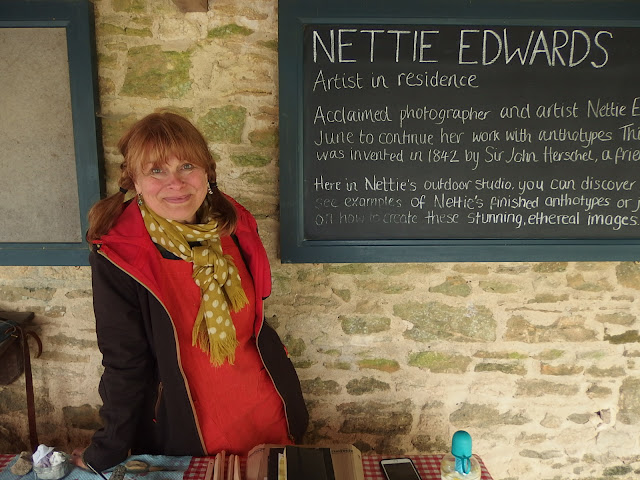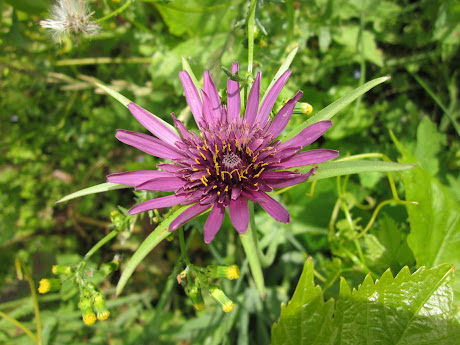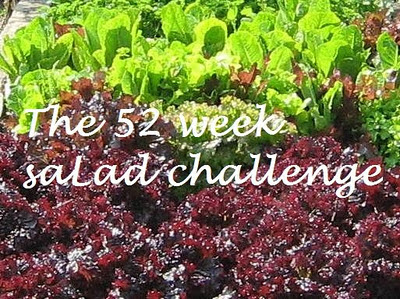Colour from the garden
Sometimes even the most familiar things in life can offer a surprise which sets you off in a completely different direction. This is exactly what happened to me at Lacock Abbey recently - the garden I visit the most - in the form of Nettie Edwards, pictured above.
She was based in the botanic garden showing her work with anthotypes, a technique which uses plants as the light sensitive material to produce a photographic print. The technique itself is well over a century old, and until Nettie's demonstration I hadn't realised it's easy to do at home.
 |
| The studio on the day I did pop by - Twitter screen grab courtesy of Nettie Edwards |
All that's needed is some suitable plant material, a means to extract its juices, a paper and frame for printing, a positive image for reproduction, a source of light, and plenty of time. The combination of two of my favourite things - photography and gardens - got me fired up and itching to get started. Nettie's enthusiasm for her work also helped :)
 |
| Click to enlarge if needed. Note the scan hasn't quite reproduced the actual colours, but you get the idea |
From this I can instantly see which plants look the most likely candidates to play with - Centaurea montana, Clematis 'Arabella', buttercup, red berberis leaf, Rosa 'The Fairy' and Geranium psilostemon. The Monarda leaf result looks far better in real life (a lovely light green), so I've added it to my list.
Nettie's currently experimenting with 'Bull's Blood' beetroot and Allium christophii heads, though the latter came out a little disappointing in my test. Sue Carter - Lacock's Head Gardener - is growing a range of other plants for her to try and a tweet on June 13th, shows foraged wild garlic paste, and another on June 12th some gorgeous deep flower colours. Berries and other juicy produce are other possibilities to try.
My next consideration is which of my shortlisted plants can produce enough extract to coat the paper I'm going to use. I've reluctantly discarded the electric colours of the Centaurea and geranium as these currently only have a few flowers. The rest are up for grabs - watch this space!
Notes about the process for my future experiments
 |
| New growth on Berberis thunbergii 'Gold Ring' - compare the colour obtained with old growth extract? |
Extraction
Use a pestle and mortar or a small blender. Need to filter the liquid out from the rest of the material e.g. use a tea strainer, coffee filter paper, or a clean cloth such as muslin. May need to add a few drops of water (what effect does our hard water have?) or clear alcohol (Nettie held up a bottle of vodka!) to thin down thicker extracts such as the Bull's Blood beetroot she was demonstrating.
As the material is sensitive to light, I guess it has to be used quickly. How to store to preserve its 'shelf life'... possibly in the fridge?
Paper
Don't use shiny paper, use matte so the liquid doesn't 'pool' on top of the paper. Note that chemicals in the paper can affect the final colours, depending on the chemicals used in the production process. Adding chemicals such as a few drops of lemon juice (acid), or bicarbonate of soda (alkaline) is a great way of playing around with the colours obtained. Even gently touching the damp paper with a finger can change the colour.
Several coats of plant extract may be needed to produce a colour deep enough for printing (hence the need to think about possible storage).
Drying
The paper needs to be dried in darkness before applying the next coat, or going onto printing. I'm going to use our airing cupboard.
 |
| I love the idea of linking my recent #mygardenrightnow project with anthotypes in some way |
Image selection for printing
This is a positive:positive process, so an object or a transparency is needed for the final image. Leaves e.g. ferns would be a great way of connecting my experiments with the early photographers celebrated at Lacock Abbey, especially Fox Talbot himself.
Transparencies need to have a high contrast, preferably with lots of black & white. These can be made easily by converting a digital photo into a black & white one, upping the contrast if needed, then printing it out onto acetate. An inkjet printer like we have should be fine.
Printing frame
Nettie had some lovely vintage contact printing frames, but I found later these are expensive to buy. Improvisation with various picture frames is the name of the game and I'm going to try some cheap clip frames. Nettie suggested I use masking tape to attach the image I use to the print paper. How the print is progressing needs to be checked from time to time and the masking tape prevents the image from going out of alignment.
Producing the print
The print frame + paper/positive image needs to be left for some time to develop. The sun is used as the light source needed to bleach out the white/lighter parts of the image onto the paper, so I've earmarked my south facing windowsill upstairs for the job. How long the print takes to develop depends on where in the world and the time of year. In Italy it'll probably take just a couple of hours; here at this time of year we're looking at a couple of weeks or so, depending on the weather (hence the need to check progress).
 |
| Or how about a plant portrait using the flower as the photographic material? I have so many ideas I want to try! |
After care
Unlike most photographic prints, these can't be fixed so they deteriorate when lit as the light continues the bleaching process. Prints need to be stored in darkness and brought out on special occasions for viewing (it'd be like having a secret garden!). Alternatively prints can be mounted behind museum quality glass which reduces the UV light levels.
Nettie takes photos of her finished prints, but for her it's nothing like looking at the real print itself. The ephemeral nature of the process (just like a garden is too) and the gradual decay of the print is part of the continuing life of the image.
There are anthotype images around which are over 100 years old, so it is possible to limit the loss to a slow decline. Just like there's a slow flower movement, there should be a slow photography one too.
Other notes
I love the element of unpredictability in this process. The colours obtained from a plant will vary depending on time of picking, location, climate, weather, soil type etc etc. Then there's the potential of added variation with the paper used, the extraction process, the number of coats applied to the paper, the addition of other chemicals, and a host of other things I haven't thought of, even my mood perhaps?
I'm going to enjoy lots of experimentation with this process, by playing around with it and my garden, perhaps even linking Lacock Abbey to the project in some way. In view of the time needed, please grant me the patience to carry it through...
You may also enjoy
Nettie's demonstrations continue on weekdays until the end of June. Highly recommended.
Read Nettie's description of the anthotype process and the production of her first print on her blog. Note the improvised equipment she used from what's to hand at the time. It's something I'm going to enjoy doing with my own experiments.
Read about some of my other visits to Lacock Abbey on my Garden Visits Page (or visit!). NB the curators at Lacock have a great way of linking the garden and photography together using various art and photography exhibitions, plus different installations in the garden - both temporary and permanent. It befits the place where modern analogue photography began.











Comments
Post a Comment
I love hearing from you and welcome thoughtful conversations :)
Comments aiming to link back and give credence to commercial websites will be composted!